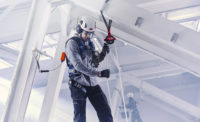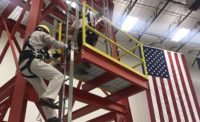Working at height continues to be one of the most dangerous industrial activities for construction workers. Falls are the leading cause of death in the construction industry—more than 200 deaths and 10,000 injuries every year in the U.S. alone—yet most injuries and deaths from falls are preventable with the proper fall protection equipment and training.
A key component of effective fall protection is a full body harness. Harnesses distribute fall forces over the upper thighs, pelvis, chest, and shoulders, in addition to providing the worker with a connection point for a complete personal fall protection system.
Harnesses are designed—and work well—to protect workers at height in fall restraint or fall arrest applications. However, a full body harness is only one aspect of fall protection safety; with a proper fall protection plan, correct equipment, and training, a fall is the exception, not the norm.
The majority of the time—in other words, when a fall is not taking place—workers are wearing their harnesses while doing jobs that often require long hours working at height, often in extreme heat, inclement weather, and precarious conditions. Harness comfort and wearability directly contribute to worker health, safety, and productivity during daily harness use as well as during a fall event.
Why harness ergonomics is critical
Simultaneously promoting fall protection, injury prevention, worker comfort, and productivity can be a major workplace challenge. In addition, worker comfort on the job directly affects worker comfort off the job, including enjoyment of life outside the workplace.
Workers at height often carry 50 pounds or more of tools and equipment. Reaching, bending, twisting, and turning—core motions for at-height workers—while carrying heavy loads can increase the risk of back and shoulder injury, not to mention fatigue. Environmental and working conditions can escalate the presence of pain or injury as muscles become starved of nutrients and waste products build up.
According to OSHA, back injuries account for a significant amount of human suffering, loss of productivity, and economic burden on compensation systems. Back disorders are one of the leading causes of disability for people in their working years and afflict more than 600,000 employees each year with a cost of about $50 billion annually—expenses that often come straight out of bottom-line business profits.
The impact of heavy weight loads on workers’ backs and shoulders—while performing work-related movements that are commonly cited as having the potential to cause back injuries—can run the gamut from lost productivity, increased insurance costs, lost work time, and decreased health and well-being of the worker.
Features of an ergonomic harness
Leading manufacturers agree that a well-designed full body harness should:
• be comfortable enough to wear throughout the workday
• allow workers to be productive for extended periods of time
• allow ease of movement, including reaching, stretching, twisting, and turning
• be adjustable around the legs, chest, and shoulders for a proper fit
• leave the worker feeling comfortable even after taking it off
Minimizing risk of injury
• Choose the right harness for the job. One harness does not fit all environments; choose the correct harness for the work situation, whether it’s a harness designed for suspension/rigging, ladder climbing, work positioning which allows for hands-free operation, or specialty material offering fire resistance or arc flash protection.
• Adjust the harness for a comfortable fit. Harnesses are designed to fit most workers; however, use the chest straps, leg straps, and other adjustments for comfort and ease of motion.
• Know how to use the harness. Every harness is designed to work a little differently. Make sure to understand how to use the harness; read the instructions and ask questions as needed.
• Inspect the harness for wear. Before every use, look for visual signs of wear and tear, fraying, loose stitching, damage, or corrosion to the belts, D-rings, attachments, rivets, webbing, frames, and buckles
When to replace a harness
The life expectancy of a safety harness varies greatly depending on how often it is used, how it is stored, and the atmospheric and situational conditions it has experienced; worn or damaged harnesses should be replaced immediately. Some manufacturers indicate the useable lifespan on the harness label.
Any harness that has been subjected to the shock loads of a fall should be removed from service and destroyed to eliminate the temptation to continue using potentially unsafe equipment.
It’s also time to review and consider replacing a safety harness when the workplace or job situation has changed, when new technology is available that has been tested to the latest safety and ergonomic standards, or when the current harness is negatively affecting the productivity, comfort, safety, or overall quality of life of workers.
When a worker experiences ongoing pain or strain on the job and after clocking out, it is time to consider an alternative harness. The negative impact of equipment that doesn’t adequately take ergonomics into consideration can last long into the future, not only impacting the ability to meet the demands of the job, but also the ability to function away from the jobsite.
The safest harness
Safety professionals agree, workers who are comfortable in their harness are more likely to wear it. And wearing a harness means safer workers.
In other words, when managing workers at height, more comfort equals more safety.



